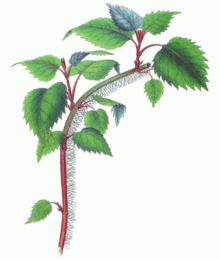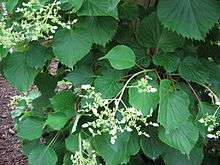Schizophragma
| Schizophragma | |
|---|---|
 | |
| Schizophragma hydrangeoides | |
| Scientific classification | |
| Kingdom: | Plantae |
| (unranked): | Angiosperms |
| (unranked): | Eudicots |
| (unranked): | Asterids |
| Order: | Cornales |
| Family: | Hydrangeaceae |
| Genus: | Schizophragma Siebold & Zucc. |
| Species | |
|
Four species, including: | |
Schizophragma (hydrangea vine) is a genus of four species of flowering plants in the family Hydrangeaceae, native to moist woodland in Asia, from the Himalayas east to Taiwan and Japan. They are vigorous, hardy deciduous lianas growing to 12 m (39 ft), cultivated for their showy flower heads borne in mid- to late summer, resembling those of the related lacecap hydrangeas.[1]
The following species and cultivars have gained the Royal Horticultural Society's Award of Garden Merit:-
The genus name Schizophragma comes from the Greek for "divided wall", referring to the split walls of the fruit.[4]
References
- ↑ RHS A-Z encyclopedia of garden plants. United Kingdom: Dorling Kindersley. 2008. p. 1136. ISBN 1405332964.
- ↑ "RHS Plant Selector - Schizophragma hydrangeoides var. hydrangeoides 'Roseum'". Retrieved 3 June 2013.
- ↑ "RHS Plant Selector - Schizophragma integrifolium". Retrieved 3 June 2013.
- ↑ Coombes, Allen J. (2012). The A to Z of plant names. USA: Timber Press. p. 312. ISBN 9781604691962.

This article is issued from
Wikipedia.
The text is licensed under Creative Commons - Attribution - Sharealike.
Additional terms may apply for the media files.